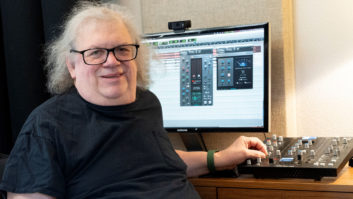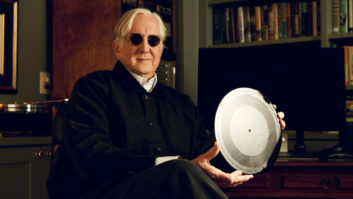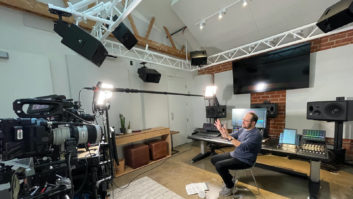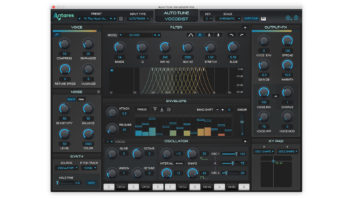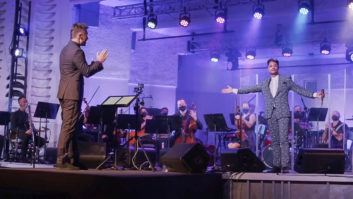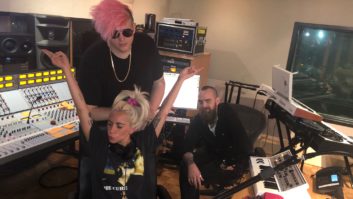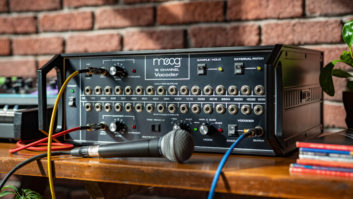Daft Punk steadfastly refuses to obey conventional rules of dance music. Unlike so much of the homogenized club fodder today, their music is carefully thought out and sculpted. They prefer to sample themselves rather than routinely sample the music of others, and they take time recording their albums, as evidenced by the four-year gap between their debut Homework and their sophomore effort, Discovery, a CD that took more than two years to create. And while the lads could be considered gearheads, they are not consumed by the technical process of constructing their music; rather, they mesh the worlds of analog and digital sounds into an eclectic, tongue-in-cheek blend.
Listening to Discovery, it is obvious that this French group appreciates ’70s funk and disco, but by the production techniques they employ, and the interweaving of other genres, such as rock and ’80s pop, the end product could only come from the current decade. The CD is a kind of retro-futurist manifesto. “A mix between the past and the future, maybe the present,” offers Guy-Manuel de Homem-Christo, on the phone from the Paris studio he shares with bandmate Thomas Bangalter. One tune exemplifying such an aural amalgamation is the instrumental “Aerodynamic,” a track that builds off a funky groove, breaks for some metallic, two-hand tapping on electric guitar, then fuses both approaches together before segueing into a spacier electronic ending. Somehow, it all works.
Discovery is an evolutionary leap forward from Homework. Whereas Daft Punk’s debut worked off of minimal elements, repeating certain loops and musical phrases over 10-minute cycles, the duo’s new album takes myriad ideas and crams them into three- and four-minute nuggets — except the closing track, a 10-minute piece called “Too Long” that serves as an in-joke for ardent fans.
“Every track has been worked really precisely, every track is a mixture of many different experiments and tricks,” remarks de Homem-Christo. “It was much more complicated making this than Homework. It was really like jewelry work, working precisely; so many different production techniques even in one track.”
The individual moods of the songs vary as well. “One More Time” is a perky party tune featuring Vocoded male vocals from Romanthony. “Superheroes” sounds like a house variation on classic “Tangerine Dream,” featuring a dreamy montage of looped vocals. On the mellower side, “Something About Us” explores a languid jazz/R&B vibe, while the interlude “Nightvision” offers a tranquil ambient experience enhanced by the gentle heartbeat rhythm of a muted kick drum. Ultimately, each composition is a world of its own.
A surprising and refreshing revelation about Daft Punk is that they play and sample their own instruments; there are live keyboards, guitar and bass involved. Many of those parts are then sampled and resampled, but de Homem-Christo estimates that half of the sampled material on Discovery was actually played live originally. “I play more guitar usually,” he says, “and Thomas plays more keyboards and bass.” But they both play all three instruments. “There’s no ego involved. We don’t argue about who’s playing what. You can get the sound of a guitar with a keyboard, or the opposite. We don’t really care about who’s doing what as long as it’s well-done. At the same time, when you use samples, you don’t have this problem. When you use a sampler, nobody plays on it, so the problem of the ego of the musician is not really there. For everything that we do, no matter how you get to the results, the important thing is the result.”
Discovery includes only four outside samples — not much for a contemporary dance record. “Around this, we play all the instruments, which are mainly vintage keyboards and guitars, so it’s a mixture of a few samples and us playing around it. We don’t always use the original sounds of the keyboards or the guitars, because we put on so many effects or distortions so that sometimes you think it’s a guitar but maybe it’s not.”
The duo uses many different samplers, preferring warm-sounding analog gear, including a Roland S-760, an Ensoniq ASR X, a Roland MPC and an E-mu SP-1200 drum machine. They use individual pieces of gear, depending upon what they can lend to a track. “To get homogeneity, we put a sample on a sample, or we play guitar and keyboard parts and try to sample and resample to get a homogenic sound,” explains de Homem-Christo. “It’s really easy to sample something but really hard to find a good sample.”
The French twosome also like to alter their original source material to create something new, whether it’s a synth or a guitar. “We don’t use too much of the original sound of the instruments; it’s really more about how we put effects on it after that,” he explains. “It’s not like we’re making a track and saying, ‘Oh yes, I need a Flying V on this one.’ We take a guitar we have [usually a Fender Stratocaster] and then try to make it sound different with the effects.”
The key principle that de Homem-Christo repeatedly invokes in discussing Daft Punk’s compositional approach is bricolage, a French term referring to the art of taking found materials (in this case, found sounds) and incorporating them into something new. “Sometimes we use an instrument in a way that it was never created for,” he explains. “Some people might say, ‘You’re doing something wrong using this effect like that,’ but we always try to do different tricks and techniques that are maybe a little bit wild for usual sound engineers. But by experimenting with some crazy ideas, you find some crazy sounds.”
To get those sounds, the pair uses many vintage keyboards, including Korg, Roland and Moog gear from the ’70s. “We use the big ones that were used in the ’70s, like the Juno. It depends on how you use it — if you put a distortion effect on a Juno, you can’t tell it’s a Juno.” Their main synths include a TR-909, TR-808, Juno-106, ARP Odyssey, E-mu 3 and AMS Phasers.
In at least one instance on Discovery, Daft Punk used a vintage keyboard to evoke a specific artist from another era. “On ‘Digital Love,’ you get this Supertramp vibe on the bridge,” remarks de Homem-Christo. “We didn’t sample Supertramp, but we had the original Wurlitzer piano they used, so we thought it would be more fun to have the original instrument and mess around with it. We use mainly vintage synthesizers, like older electric pianos like the Rhodes, Wurlitzer, Clavinet. We didn’t use the Clavinet on Discovery, but I usually use it in my studio.” Effects units the duo used include a DP-4 and an Eventide Ultra-Harmonizer.
By experimenting with some crazy ideas, you find some crazy sounds.
— Guy-Manuel de Homem-Christo
An important influence on Daft Punk’s music is FM radio compression. The sound of compressed music over the airwaves has beguiled the duo since their early years, particularly the sonic attack in a powerful car stereo system, that “big sound and enormous voice.” De Homem-Christo observes that “on some other projects, we noticed that what we liked the best was the compression, so we began to learn how to use the compression and got into compressors and how to use them. Some people like the really good sound of a guitar, and we really like the sound of compression in general. That’s one of the biggest loves we have in music-making, especially the U.S. FM radio sounds where the compression is making everything. Sometimes you like it so much that you’re really disappointed when you buy the CD.”
In their own music, Daft Punk uses a number of different compressors. “We have a really small compressor, the Alesis 3630, which is $300. That’s the main one we used on Homework and Discovery. The one we used the most is one of the cheapest ones on the market. It’s really funny; it’s the bricolage thing. Sometimes you don’t have to have the most expensive equipment to make good music.” To further his point, de Homem-Christo reveals that an early Daft Punk single (a pre-Homework release) was created simply using an Akai S01 sampler, an Alesis MicroVerb 3 sound processor, an Alesis MMT-8 sequencer and a Mini-Moog synth. “It sounded great to us,” he says.
Given the complexity of their music in terms of sonic construction, does the Daft duo keep logs of everything that they do? “We remember most of the parts, but sometimes we don’t remember exactly what effects were on it,” admits de Homem-Christo. “Knowing that each track you get so much different stuff in it, it’s hard to remember. Sometimes you get real nice stuff by random or mistake. It’s a combination of mistakes and things done on purpose.” Ironically, this emphasis on the sonic “bottom line” almost makes de Homem-Christo and his partner sound like businessmen, but the warmth of their music says otherwise.
When it comes to recording and mixing their music, Daft Punk utilizes a modest setup. “We never have gone to a big studio to do anything,” says de Homem-Christo. “We have a small Mackie 12-channel mixer, and everything is done there by bricolage.” They use Logic Audio on an iMac DV, and they record to a Sony DAT, direct into the iMac or Revox A77/B77 analog recorder, depending upon the sound they want. But even de Homem-Christo admits that he does not like to explain the band’s technical process too in-depth. He does not want to give away too much. A good magician never reveals his secrets.
